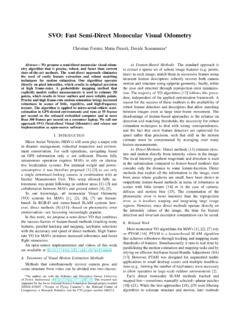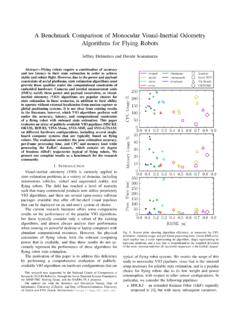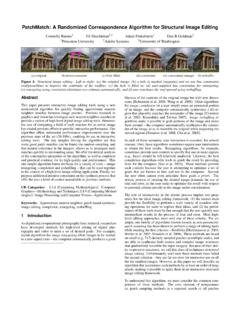Transcription of SVO: Fast Semi-Direct Monocular Visual Odometry
1 SVO: fast Semi-Direct Monocular Visual OdometryChristian Forster, Matia Pizzoli, Davide Scaramuzza Abstract We propose a Semi-Direct Monocular Visual odom-etry algorithm that is precise, robust, and faster than currentstate-of-the-art methods. The Semi-Direct approach eliminatesthe need of costly feature extraction and robust matchingtechniques for motion estimation. Our algorithm operatesdirectly on pixel intensities, which results in subpixel precisionat high frame-rates. A probabilistic mapping method thatexplicitly models outlier measurements is used to estimate 3 Dpoints, which results in fewer outliers and more reliable and high frame-rate motion estimation brings increasedrobustness in scenes of little, repetitive, and high-frequencytexture.
2 The algorithm is applied to micro-aerial-vehicle state-estimation in GPS-denied environments and runs at 55 framesper second on the onboard embedded computer and at morethan 300 frames per second on a consumer laptop. We call ourapproach SVO ( Semi-Direct Visual Odometry ) and release ourimplementation as open-source INTRODUCTIONM icro Aerial Vehicles (MAVs) will soon play a major rolein disaster management, industrial inspection and environ-ment conservation. For such operations, navigating basedon GPS information only is not sufficient. Precise fullyautonomous operation requires MAVs to rely on alterna-tive localization systems. For minimal weight and power-consumption it was therefore proposed [1] [5] to use onlya single downward-looking camera in combination with anInertial Measurement Unit.
3 This setup allowed fully au-tonomous way-point following in outdoor areas [1] [3] andcollaboration between MAVs and ground robots [4], [5].To our knowledge, all Monocular Visual Odometry (VO) systems for MAVs [1], [2], [6], [7] are feature-based. In RGB-D and stereo-based SLAM systems how-ever, direct methods [8] [11] based on photometric errorminimization are becoming increasingly this work, we propose a Semi-Direct VO that combinesthe success-factors of feature-based methods (tracking manyfeatures, parallel tracking and mapping, keyframe selection)with the accurracy and speed of direct methods. High frame-rate VO for MAVs promises increased robustness and fasterflight open-source implementation and videos of this workare available at: Taxonomy of Visual Motion Estimation MethodsMethods that simultaneously recover camera pose andscene structure from video can be divided into two classes: The authors are with the Robotics and Perception Group, Universityof Zurich, Switzerland This research wassupported by the Swiss National Science Foundation through project number200021-143607 ( Swarm of Flying Cameras ), the National Centre ofCompetence in Research Robotics, and the CTI project number ) Feature-Based Methods.
4 The standard approach isto extract a sparse set of salient image features ( points,lines) in each image; match them in successive frames usinginvariant feature descriptors; robustly recover both cameramotion and structure using epipolar geometry; finally, refinethe pose and structure through reprojection error minimiza-tion. The majority of VO algorithms [12] follows this proce-dure, independent of the applied optimization framework. Areason for the success of these methods is the availability ofrobust feature detectors and descriptors that allow matchingbetween images even at large inter-frame movement. Thedisadvantage of feature-based approaches is the reliance ondetection and matching thresholds, the neccessity for robustestimation techniques to deal with wrong correspondences,and the fact that most feature detectors are optimized forspeed rather than precision, such that drift in the motionestimate must be compensated by averaging over ) Direct Methods:Direct methods [13] estimate struc-ture and motion directly from intensity values in the local intensity gradient magnitude and direction is usedin the optimisation compared to feature-based methods thatconsider only the distance to some feature-location.
5 Directmethods that exploit all the information in the image, evenfrom areas where gradients are small, have been shown tooutperform feature-based methods in terms of robustness inscenes with little texture [14] or in the case of camera-defocus and motion blur [15]. The computation of thephotometric error is more intensive than the reprojectionerror, as it involves warping and integrating large imageregions. However, since direct methods operate directly onthe intensitiy values of the image, the time for featuredetection and invariant descriptor computation can be Related WorkMost Monocular VO algorithms for MAVs [1], [2], [7] relyon PTAM [16]. PTAM is a feature-based SLAM algorithmthat achieves robustness through tracking and mapping many(hundreds) of features.
6 Simultaneously, it runs in real-time byparallelizing the motion estimation and mapping tasks and byrelying on efficient keyframe-based Bundle Adjustment (BA)[17]. However, PTAM was designed for augmented realityapplications in small desktop scenes and multiple modifica-tions ( , limiting the number of keyframes) were necessaryto allow operation in large-scale outdoor environments [2].Early direct Monocular SLAM methods tracked andmapped few sometimes manually selected planar patches[18] [21]. While the first approaches [18], [19] used filteringalgorithms to estimate structure and motion, later methods[20] [22] used nonlinear least squares optimization. All thesemethods estimate the surface normals of the patches, whichallows tracking a patch over a wide range of viewpoints,thus, greatly reducing drift in the estimation.
7 The authorsof [19] [21] reported real-time performance, however, onlywith few selected planar regions and on small datasets. A VOalgorithm for omnidirectional cameras on cars was proposedin [22]. In [8], the local planarity assumption was relaxedand direct tracking with respect to arbitrary 3D structurescomputed from stereo cameras was proposed. In [9] [11],the same approach was also applied to RGB-D DTAM [15], a novel direct method was introducedthat computes a dense depthmap for each keyframe throughminimisation of a global, spatially-regularised energy func-tional. The camera pose is found through direct whole imagealignment using the depth-map. This approach is compu-tationally very intensive and only possible through heavyGPU parallelization.
8 To reduce the computational demand,the method described in [23], which was published during thereview process of this work, uses only pixels characterizedby strong Contributions and OutlineThe proposedSemi-Direct Visual Odometry (SVO) al-gorithm uses feature-correspondence; however, feature-correspondence is an implicit result of direct motion estima-tion rather than of explicit feature extraction and , feature extraction is only required when a keyframeis selected to initialize new 3D points (see Figure 1). Theadvantage is increased speed due to the lack of feature-extraction at every frame and increased accuracy throughsubpixel feature correspondence.
9 In contrast to previousdirect methods, we use many (hundreds) of small patchesrather than few (tens) large planar patches [18] [21]. Usingmany small patches increases robustness and allows neglect-ing the patch normals. The proposed sparse model-basedimage alignment algorithm for motion estimation is related tomodel-based dense image alignment [8] [10], [24]. However,we demonstrate that sparse information of depth is sufficientto get a rough estimate of the motion and to find feature-correspondences. As soon as feature correspondences andan initial estimate of the camera pose are established, thealgorithm continues using only point-features; hence, thename Semi-Direct .
10 This switch allows us to rely on fast andestablished frameworks for bundle adjustment ( , [25]).A Bayesian filter that explicitly models outlier measure-ments is used to estimate the depth at feature locations. A3D point is only inserted in the map when the correspondingdepth-filter has converged, which requires multiple measure-ments. The result is a map with few outliers and points thatcan be tracked contributions of this paper are: (1) a novel Semi-Direct VO pipeline that is faster and more accurate thanthe current state-of-the-art for MAVs, (2) the integrationof a probabilistic mapping method that is robust to Model-basedImage AlignmentFeature AlignmentPose & Structure RefinementMotion Estimation ThreadNew ImageLast FrameMapFrameQueueFeatureExtractionIniti alizeDepth-FiltersMapping ThreadIs Keyframe?









